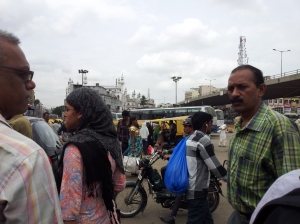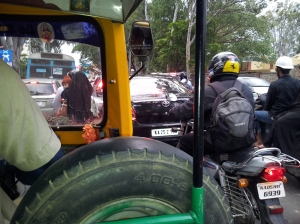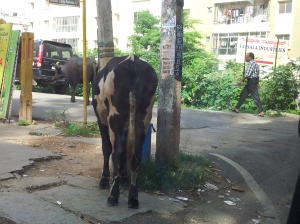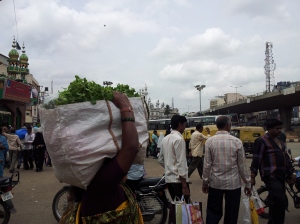There has been a short hiatus here as I have just come back from India – Bangalore to be precise, and as many people are aware, Bangalore is now the IT hub of India – and possibly the world, as every IT firm has offices there now. Also it seems most of the call centres of the world are there too. Call centres and support desks are the main source of income but programming outsourcing and associated technology development feature heavily too.
Now as we are talking world-wide activity, the offices etc operate 24/7, which means that there are 3 shifts a day. So people are moving to and from their work 3 times a day in 2 hour chunks of movement. and more…
If we were in the UK or the US I’m sure the majority of these offices would be nicely situated in a Technology Park – all together – and roads and supporting transport facilities would have been put in place before they were allowed to build and inhabit. this is India however, and what has happened is that the firms have built wherever they could negotiate for a nice parcel/plot of land – even if there were old buildings, trees or anything else (including farms and elephants) on the land already – even if there wasn’t a road currently leading to it. So the offices are all over the city.
The hotel that I was staying at was, 15 years ago, outside the city . Now the city is 20 kilometers outside the hotel – right in the elephants’ grazing lands. More of that later.
The daily commute looks something like this:
But then there are complications like this from time to time:
Yes, there are still cows and water buffalo roaming around in Bangalore, eating from wherever they can find something tasty – including rubiish bins if they take their fancy. The central market of course is full of such rubbish and is amazingly busy too:
The traffic jams last 2 hours for sure and you need to allow over an hour just to go a very short distance. This is complicated of course, by the fact that the taxi drivers don’t read maps, they don’t have satnavs, and only know the small area in which they operate. So if you ask them to go across town, it usually involves a long discussion about the main sights they might recognise and then several stops when you get near your destination, to confirm they are, or are not, going the right way. Of course, one-way systems don’t help… but they are very few traffic lights or roundabouts – but lots of very ‘interesting’ driving styles. If there isn’t enough room at the junction for you to join a queue, you make your own – usually on the ‘wrong’ side of the road – and as for ‘illegal’ manoeuvres – what’s illegal? A tuk-tuk or the open cabs are the quickest way around as a tourist as they can get into smaller spaces…!
Now we come to why the elephants were on the rampage. Seriously so. They injured several people who were in their path as they tried to get to water and their old remembered grazing land (they were supposed to stay within an electric fence, but they trampled it) as their grazing dried up. All they wanted was the land and trails they remembered back – but the city has engulfed them and they are no more…
The city has engulfed the forest too – and where once roads were lined with trees, now they have gone too. The only trees left are in the protected environments of a few very small parks, the Botanical Garden – more of which in a later post, and the environments of the two big national universities – again more later.
The roads are not yet complete and there are no pavements to walk on and every afternoon/evening it rains but not really mud as the soil is sandy. In fact, Bangalore has no natural water and had to have a reservoir built when it was settled by Tipu Sultan in the 17th century. Not only are the roads not complete but nor is the Metro – and yet they are talking about altering the fares for the most popular stations – yet only 6 of 36 are even built! The road to airport – whilst not yet complete (we ended up driving across a pavement at one point to get round a corner where the road ended) they believe it needs more carriageways… to help prevent speeding there are speed humps – intentional – and lots that are not intentional – as well as lots of pot-holes, so a maximum speed of 8 miles an hour is really going fast!
Now more about the elephants:
The Task Force recommends: 1. an conservation zone; 2. no commercial building near the zone; 3. partnerships to secure farm land; 4. elephant proof barriers to prevent them from straying onto farms; 5. help line for those injured by elephant attacks; 6. payments for any crop destruction; 7. review any already granted planning permissions within the zone; and 8. experimenting with moving family groups to a new location.
Wild life experts are not impressed as the forest is no longer there to provide the safe corridor from one area to another for the elephants – who are getting hungry. The habitats have already vanished under building and mining they argue.
It will be interesting to see how progress, if any is made – monitor the elephants and Bangalore!
Related articles
- How Bangalore uses speed-breakers instead of traffic lights.. (mostlyeconomics.wordpress.com)






What a pity we cannot admit the fault lies with a plague of humans. A job for the Daleks I think. Anyone for Dr Who?
LikeLike
Well not the Doctor perhaps but Daleks or Transformers perhaps…. Yes, 15 years ago this was forest land and not within the city hence their ‘old’ known trails now cross city land.
LikeLike
Incredible India! Namaste. . .Anne
LikeLike
Namaste! I usually adore India but this was not the best city – luckily I was not a tourist but there for work…thanks for reading the blog.
LikeLike
Hope next time is a furn time. .. ..namaste. . . .Anne
LikeLike